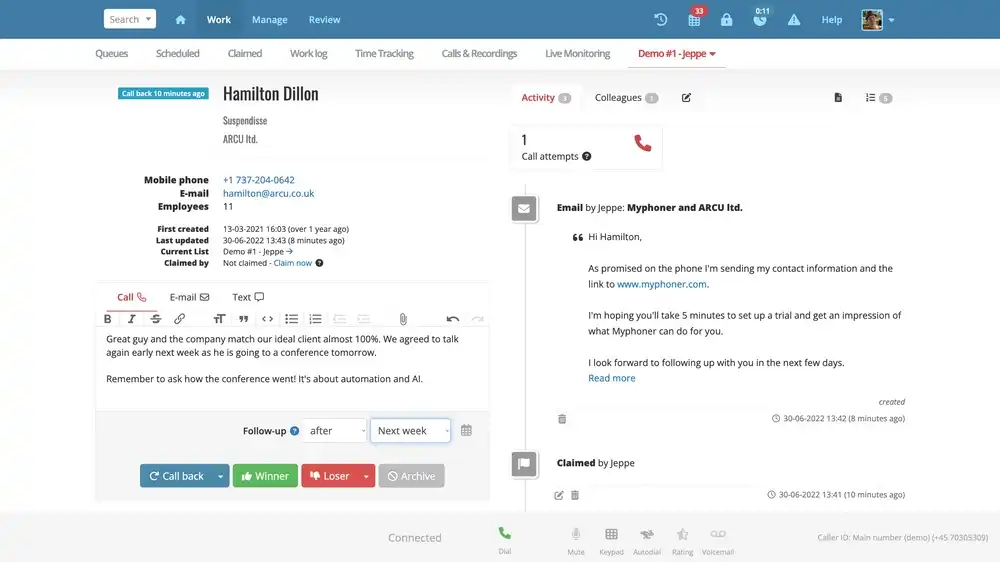Inbound vs Outbound Sales: Which One Should Startups Focus On

- September 17, 2022
There are plenty of other things you should worry about as a startup founder - like how to keep your startup afloat or attract customers in the first place.
There are plenty of other ways to get customers than burning money through advertising.
Inbound and outbound sales are just two sides of the same coin: they're both ways to get in front of potential customers, and they both require some amount of marketing to make sure that people know who you are and why they should buy from you.
So which one should you use? That's what we'll walk you through in this guide!
Quick pause to highlight Myphoner. Don't worry, your article resumes below.
Selling to undefined over the phone?
Use our sales dialer to call customers and prospects in undefined at the most competitive rates

Inbound Sales Strategy: When Is Inbound The Right Choice?
Inbound sales result from a lead generated by a potential customer reaching out to your organization through an inquiry about its products or services. You nurture the leads until they become customers ready to purchase from you.
As a startup, you don't have the resources to waste time and energy on strategies that won't pay off.
Therefore, you need to know when it makes sense to pursue inbound sales. But first, let's take a look at how the process works.
Inbound can be broken down into four phases, also known as the flywheel model.
-
Attract: You attract potential customers by creating relevant content for them and their needs. This can include blog posts, videos, infographics, and more!
-
Engage: This phase aims to position you as an industry expert so your target audience can feel comfortable asking questions or conversing with you.
-
Delight: Once someone has become a customer, you must continue to delight them so that they come back for more.
That said, you can use an inbound sales strategy when:
1. Your sales team isn’t prepared for outbound selling tactics
Many startups don't have the time or resources to hire outbound salespeople, so they try to do it themselves.
But they don't know how to run cold calls and make appointments, so they give up before they ever get started. Inbound sales allow you to work with your existing staff and automate most of the process, so you can keep moving forward even if you don't have as much cash on hand as some larger companies do.
2. Your product or service is complex
If you sell something that requires a lot of explanation and education, like a SaaS product or a technical service, then inbound sales can be a good fit.
For example, if you sell a software product, your sales team needs to explain how it works and why customers should buy it. You also must ensure they are skilled at communicating with prospects who are not technical.
3. Limited resources
As a startup, you may not have money to spend on outbound sales strategies like cold calling or emailing. But with inbound, create content that attracts potential customers and builds trust over time — without paying any money upfront.
Why? It's focused on content marketing and SEO to attract new leads and convert them into customers.
Inbound marketing can be a great way to generate leads, but it's essential to understand its pros and cons. Here are some of the pros and cons of inbound:
Inbound Sales Pros
-
Cost-Effective - Inbound sales strategies cost less than outbound marketing. You don't have to spend money on advertising or other expensive methods to attract new leads. Instead, you focus on creating quality content that people want to read.
-
More Targeted Leads - With outbound marketing, there's no guarantee that your ads will reach the right people — especially if you're using PPC ads or other paid platforms for lead generation. Inbound, however, you can target specific groups of people based on their interests and needs so that they're more likely to engage with your content and become a lead (or even a customer).
-
Easy-to-track ROI metrics - Inbound marketing allows you to track every step to see how much revenue each part generates for your business. This makes it easier to determine what works best for your company to leverage them.
-
Scalable - You don’t have to hire dozens of employees to manage an inbound sales system. One or two people who can write blogs and manage social media channels will do the trick. This makes inbound marketing scalable for any organization that wants to snowball but doesn’t have unlimited funds for staffing up right away.
Inbound Sales Cons
-
It doesn't work for all businesses - Inbound sales strategies aren’t ideal for every business. You'll probably have to invest in other marketing channels if you're selling an expensive or complicated product.
For example, it's hard to rely on organic search traffic alone to generate leads for enterprise software. Your company may need more paid advertising and content marketing assets.
-
Time-consuming - It takes time to build up your content marketing machine. You need a website, create quality content, find your target audience, and build links to your site. This process may take months before you start seeing results.
Outbound Sales Strategy: When You Need To Turn To Outbound
Outbound sales involve contacting people who could use your product or service rather than waiting for them to come to find out about it on their own.
It’s better when you have large volumes of leads or prospects scattered across different geographies and industries.
These are often referred to as cold leads because they're not already familiar with your company or brand. Let's focus on instances when an outbound sales strategy is the best option:
1. When Targeting an audience unfamiliar with your brand
This could include people who may not even be looking for your product or service.
For example, say a large technology company wants to sell its services to small businesses that don't currently use technology in their operations — those businesses would probably be considered "cold" leads since they aren't actively searching for solutions like this yet.
2. When competitors are already doing it
If your competitors have been using outbound for years and have made it a core part of their business strategy, then there's no reason why you shouldn't do the same.
As long as you’re capable, it makes sense to follow suit, expand into new markets, and bring more customers on board.
3. If you want to target a specific demographic of buyers
It’s easy to fall into the trap of thinking that any sale is a good sale. But that isn’t always true — especially regarding outbound sales.
Suppose you have a demographic of buyers that are highly responsive, like doctors or dentists. In that case, you can get away with using an outbound strategy without having a lot of experience with cold-calling and sales.
4. If your products have a long sales cycle
Outbound sales is often necessary if you sell complex products or services requiring multiple meetings before closing a deal.
For example, prospects might take several weeks to buy from you if you sell enterprise software requiring implementation services.
Outbound Sales Pros
-
Generate more leads - Since outbound sales talk directly with customers, it generates leads that can help you in future campaigns or events.
For example, if you talk to someone on the phone and they express interest in your product or service but do not want to buy it now, then you can add them to your email list so that they get updates about your new products or services in the future.
-
There Is human contact - With inbound marketing, there's no human contact - everything is automated with emails and social media posts. With outbound sales, however, there are real people on the other end of the line who can answer questions and help customers find what they need or want.
-
Constant exposure - Outbound sales are often used to generate leads, which other team members can follow up on later. This means that each outbound call has the potential to lead to multiple opportunities with different companies, which means you'll always have something new coming in.
-
Targeted Approach - When using outbound sales, you can target specific companies interested in your offer. This means you don't have to waste time trying to sell something to someone who isn't interested in buying.
Outbound Sales Cons
-
Potential legal issues - Cold calling techniques, such as telephone calling or door-to-door selling without permission from people who don't want to be bothered with unsolicited solicitations, may run into problems with federal and state laws governing telemarketing practices.
-
Lack of control - You may not have as much control over what is said about your products or services as you would like because employees may make up their own stories about why people should buy from them instead of from you directly.
-
No guarantee of success - There's no guarantee that an outbound call will turn into an actual sale — even if someone is appropriately trained and has all the correct information at his fingertips when he makes the call.
-
High cost of implementation - The initial investment required to set up and maintain an outbound sales strategy is relatively high.
Expenses include phone service charges, office supplies, and telephones. Whether or not the outbound sales strategy is successful, you must pay for these costs. However, it doesn’t have to be that expensive, thanks to some tools like Myphoner which make it simpler and more affordable.
Inbound vs. Outbound sales: Which Is the Right One For Startups
So, what's the verdict? Inbound or outbound? Which one is right for your startup?
Well, it depends. If you have a lot of time on your hands and want to spend reaching out to prospective customers, then outbound might be the way to go. But if you're busy and want to focus on improving your product, then inbound is a better option.
If you're not sure how to start, here are some quick tips:
For inbound sales:
- Create a landing page that is designed explicitly for leads who are interested in what you're selling.
- Have an email ready that you can send them with a link back to your landing page.
- Ensure the landing page includes all the information they'll need before buying. (e.g., price, product description, etc.)
For outbound sales:
- Know what kind of leads you want and how much they cost before reaching out so that you don't waste time on people who aren't interested in what you have to offer.
- Always have something new to offer that might pique their interest and get them invested enough in your product or service to buy from you instead of someone else!
But at last, the best way to succeed at marketing is all about balance: take care of inbound activities while simultaneously reaching out to people through outbound efforts.

Written by
Daniel Vincent
I'm Daniel! Head of Customer Success here at Myphoner. Over the past (almost) decade, I've worked with multi-national corporations as well as a handful of start-ups to transform their support experience into something truly exceptional.
At Myphoner, I spend most of my time trying to understand our client's experience and thinking of ways to improve it. My wish is for all our clients to be enabled to unleash the power of Myphoner within their businesses.
Related articles

Tools & Practices
LeadFuze Review - Transforming the way you generate leads
Boost sales with effective lead generation using LeadFuze. Our guide explores what it is and how to use it effectively to identify potential customers with ease.
March 9, 2023

Tools & Practices
Best CRM for Call Centers 2023 — And How to Choose
CRM software is a game-changer for call centers. It helps agents impress customers, and is crucial in improving appointment setting and phone outreach performance.
March 2, 2023

Tools & Practices
Call Management: What is Call Management and How Can it Help Your Business
Discover how call management can improve your business communication and customer experience. Learn different routing systems and best features. Choose wisely!
February 17, 2023